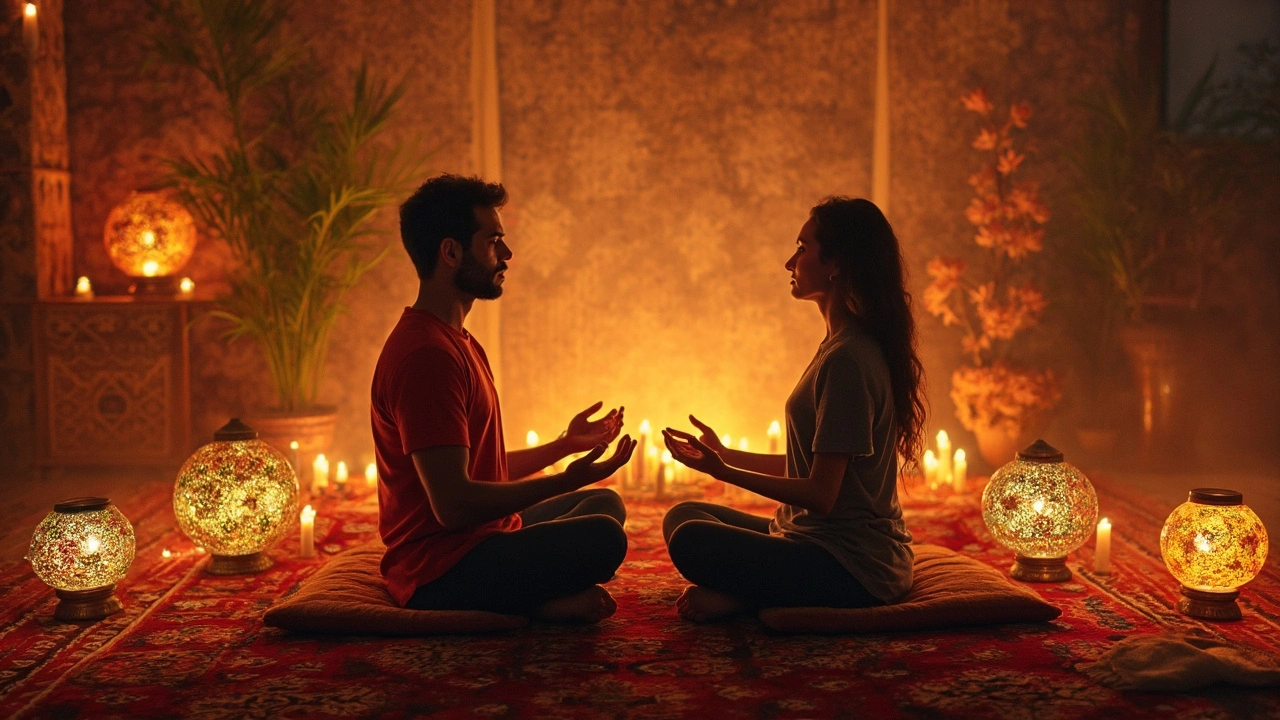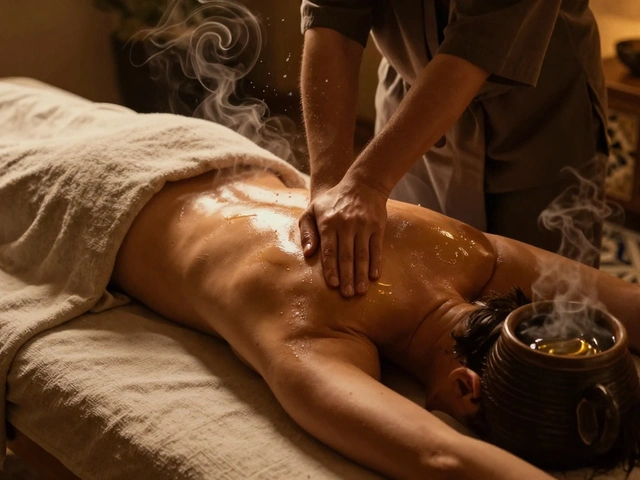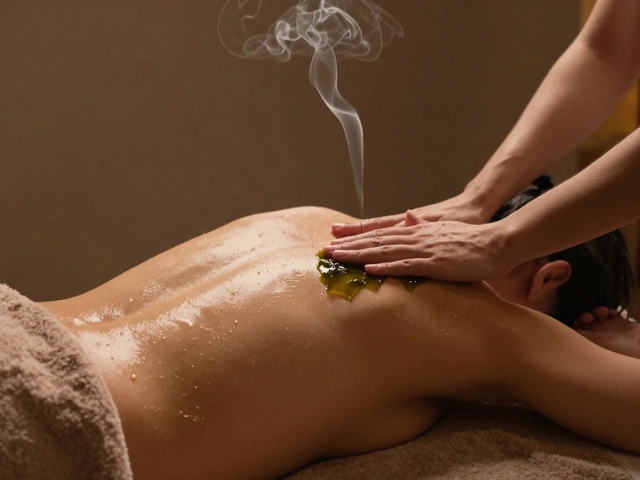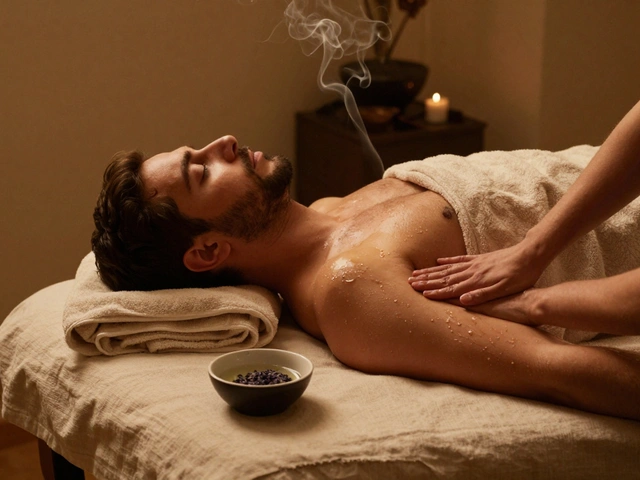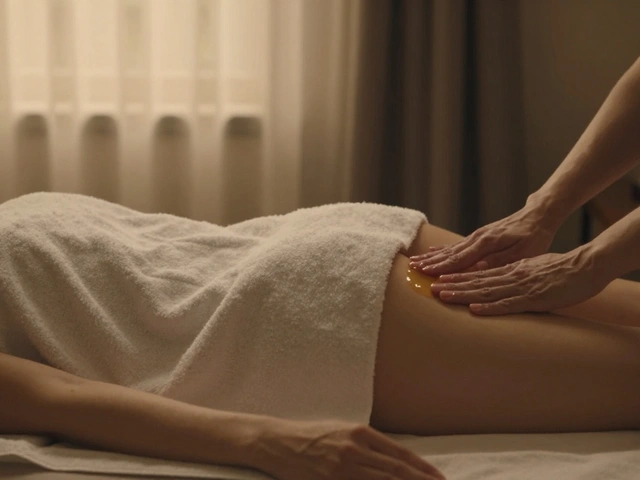Most people think tantra massage is mysterious or only about intimacy, but there's some real science behind how it works. If you've ever felt stress melt away after a regular massage, imagine that with an extra layer of body awareness and relaxation techniques thrown in.
Tantra massage isn’t just about touch—it taps into your body’s natural energy systems (some call these chakras, but you don’t have to buy into that to benefit). By focusing on breath, slower movements, and mindful touch, tantra massage helps calm your nervous system and increase your sense of connection.
A lot of folks report feeling more alive, less anxious, and more in tune with themselves after a proper session. And yes, this isn’t just about spiritual talk! When you relax deeply and breathe rhythmically, your body releases hormones like oxytocin and endorphins, which are proven to boost your mood and reduce pain. Sound good? You’ll want to know how these sessions actually go, what options you have, and how much to expect to pay—so let’s break down what really matters if you’re curious or considering booking a session.
- Key Points and Direct Answer
- What Is Tantra Massage? Science and Context
- Top Benefits and Real-Life Stories
- Types of Tantra Massage and How to Choose
- What Happens in a Session: Step-by-Step
- Safety, Pricing, and Booking Tips
What Is Tantra Massage? Science and Context
Tantra massage mixes ancient Indian traditions with modern bodywork. Unlike a typical spa massage that just works your muscles, tantra massage has this extra focus on energy, breath, and being super present in the moment. The roots go back thousands of years to Tantra—a set of spiritual practices designed to help people feel more connected to themselves and others.
So, what really makes tantra massage different? Instead of rushing over body parts, a tantra practitioner uses slow, mindful touches, deep breathing guidance, and sometimes even meditation. The aim is to activate your body’s relaxation response and boost self-awareness—not just make your muscles feel better. Studies have shown that breathwork and focused touch can lower cortisol, which is the stress hormone, and increase dopamine and oxytocin, which help you feel happy and close to others.
Here’s a quick table to make things clear—what happens in the body during a tantra massage compared to a regular massage:
| Effect | Regular Massage | Tantra Massage |
|---|---|---|
| Muscle Relaxation | ✓ | ✓ |
| Breath Guidance | Sometimes | Always |
| Mindfulness/Meditation | Rare | ✓ |
| Energy Flow (Chakras) | No | ✓ |
| Hormone Boost (Oxytocin) | ✓ (mild) | ✓ (stronger) |
Experts say tantra massage, when done right, taps into the body’s vagus nerve, which helps switch you from fight-or-flight mode into rest-and-digest mode. You may notice lower blood pressure and less muscle tension, not just during but even after a session. This makes tantra massage a legit option if you want to feel more balanced, both physically and emotionally.
If you’re worried it’s going to get ‘weird’ or need you to be spiritual—that’s not required. Most people come for the science-backed benefits of deep relaxation and end up surprised by how connected and calm they feel afterward. The main point: tantra massage is about using time-tested tools—breath, touch, and awareness—to reset your body and mind in a way most standard massages just can’t pull off.
Top Benefits and Real-Life Stories
When you hear about tantra massage, you probably want to know what it actually does for people. Turns out, the perks are not just hype—there are some concrete benefits that people experience again and again.
- Stress relief: The deep breathing and slow, mindful touches in tantra massage help lower your stress hormone levels. You’ll find yourself breathing easier and letting go of worries.
- Better mood: The body releases endorphins and oxytocin during a session, both known to lift your mood and make you feel more relaxed or even happier for days after.
- Deeper body awareness: Many folks say tantra massage helps them tune in to what their body needs. You might notice patterns of tension you didn’t even realize you had.
- Boosted intimacy (solo or partnered): This type of massage often helps people feel more comfortable in their own skin. Some couples use it to reconnect when life gets hectic.
- Reduced aches and tension: Studies show massage therapy in general helps reduce chronic pain and muscle tightness, and tantra massage includes plenty of gentle, targeted touch.
One story comes from Jen, a mom who felt totally burnt out from nonstop family duties. After her first tantra session, she noticed she felt lighter—almost like someone hit a reset button on her mood. She told me the calm lasted all week, and she even started sleeping better.
There’s also a guy named Sam, always glued to his laptop. He figured tantra massage was “just another wellness trend.” But after trying it, he couldn’t get over how relaxed his back and shoulders felt. He said the breathing exercises stuck with him, and now he uses them when work stress hits.
The point is, people turn to tantra massage for different reasons—stress, pain, improved body image, or just curiosity—but most walk away with more than they bargained for. The science lines up with the testimonials: slowing down, breathing deeply, and focusing on touch does wonders for your head and body. If you’re hoping for results you can actually feel, tantra massage is worth a try.

Types of Tantra Massage and How to Choose
If you’re exploring tantra massage, you’ll quickly see there’s not just one style. The experience you get depends a lot on the type you pick and the therapist’s approach. Here are some of the most popular types you’ll run into, and what sets them apart:
- Classic Tantra Massage: This style focuses on full-body, mindful touch, usually combined with guided breathing. Often used for deep relaxation and increased body awareness.
- Yoni and Lingam Massage: These are gender-specific, focusing on female or male intimate areas. People often seek these for emotional or energetic healing, not just pleasure.
- Neo-Tantric Massage: Modernized and mixed with Swedish or deep tissue massage methods. Great for beginners or anyone a bit nervous about traditional tantra settings.
- Kashmiri Tantra Massage: Uses slow, synchronized movements often done side-by-side. This feels more meditative and bonding, perfect for couples or close partners.
- Couples Tantra Massage: Designed for two, guided by a therapist. It’s about building trust, intimacy, and better communication between partners.
Dr. Charlotte Howard, a certified sex therapist, sums it up well:
“Tantra massage is less about technique and more about intention and presence. Each style has its own focus, but the real magic happens when you find something that fits your comfort level and curiosity.”
Trying to pick the right style? Here’s a simple decision table to help you out:
| Type | Best For | Comfort Level Needed | Solo/Couples |
|---|---|---|---|
| Classic Tantra | Stress relief, body awareness | Beginner | Either |
| Yoni/Lingam | Healing, deeper intimacy | Moderate | Solo |
| Neo-Tantra | Relaxation, newcomers | Beginner | Either |
| Kashmiri | Meditative, deep connection | Comfortable with touch | Either (best as couple) |
| Couples Tantra | Building trust, communication | Comfortable | Couples |
If you’re new, it’s smart to start with a classic session or neo-tantric massage. Ask the therapist what styles they offer and be upfront about your comfort zone and goals. Some places even let you combine techniques so the session is unique to you. Always check reviews and confirm the therapist’s training, since this makes a big difference in both safety and how comfortable you’ll feel.
What Happens in a Session: Step-by-Step
If you’ve never tried a tantra massage before, you probably have loads of questions. It sounds a little mysterious, but the best way to break down what actually happens is to walk through the session step by step. No guesswork, no weird surprises—here’s what usually goes down during a real tantra massage.
The basic process looks like this:
- Arrival and Intake: First, you show up—usually at a studio or spa that offers trained tantra massage therapists. There’s always a private room. You’ll chat a bit about what you’re looking for and maybe fill out a short form, just like you would at a regular massage spot.
- Setting the Mood: The therapist gets the room comfortable. Expect soft lighting, quiet music, maybe some candles. This isn’t just for ‘vibes’—it actually helps your body start to relax.
- Guided Breathing: Most sessions kick off with simple breathing exercises. The therapist might guide you to slow down your breath. There’s real science here: deep breathing drops your heart rate and tells your nervous system you’re safe.
- Gentle Touch and Body Scanning: The therapist uses light, slow strokes to help you get tuned into your body. This might sound basic, but it’s key for helping your mind focus and let go of stress.
- Full-Body Massage: Here’s where it gets different from your typical back rub. The therapist uses a mix of long strokes, light pressure, and sometimes holds certain spots to build body awareness. There’s no rush—it’s about going slow and paying attention to how things feel.
- Optional Energy Work: Some sessions include hands-off techniques where the therapist moves their hands just above your skin. Some people feel tingling or heat; others just feel relaxed. You can skip this part if it’s not your thing.
- Closing and Integration: Once the massage wraps up, you’ll usually have a moment to chill. The therapist might talk you through how you’re feeling or suggest a few grounding tips before you leave.
Tantra massage is all about comfort—your boundaries are always respected. If you’re uncomfortable, say something. Legit therapists will never pressure you to do anything you don’t want to do.
If you like concrete info, here’s a quick breakdown of what a standard session looks like at most professional spots:
| Session Length | 60 to 120 minutes |
|---|---|
| Average Cost (US) | $120 - $350 per session |
| What to Wear | Usually undress to your comfort level (often nude, but covered with a towel if you want) |
| Privacy Guaranteed? | Yes, private rooms and confidentiality are standard |
| Who Can Book? | Adults only (18+) |
A final tip: always ask the therapist if you’re unsure about any part of the process. A good session will leave you feeling relaxed—not awkward or uneasy. The secret sauce behind a real tantra massage is the focus on slowing down, listening to your own comfort, and being present throughout the experience.

Safety, Pricing, and Booking Tips
Before you jump into booking a tantra massage, safety should be your number one priority. The world of bodywork is amazing—but you really want to make sure you’re in the right hands. Always check that the practitioner is certified or has solid reviews on platforms like Google, Yelp, or trusted wellness communities. No one wants their first experience to feel sketchy or awkward.
It’s totally normal to ask about hygiene and COVID precautions. Clean rooms, new sheets for each client, and all touchable surfaces cleaned between sessions are pretty standard now. If you’re ever unsure, ask the therapist directly or look for spa listings that mention these details online.
Talking about boundaries is just as important. Reputable tantra massage therapists are open to discussing what you’re comfortable with (and what’s a hard no). Never feel pressured—your comfort matters more than anything.
Now, onto money—the least relaxing part! Pricing for a tantra massage varies a lot. In major cities, you’ll usually see prices range from $120 to $300 an hour, depending on therapist experience, the type of session (classic, couples, therapeutic), and location. Some day spas offer intro rates or package deals for multiple visits, which can make things more affordable if you’re planning more than one session. Here’s a quick look at common price ranges:
| Session Type | Typical Price | Duration |
|---|---|---|
| Classic Tantra Massage | $120–$180 | 60 mins |
| Extended/Deep Session | $200–$300 | 90–120 mins |
| Couples Tantra | $200–$400 | 90+ mins |
Booking is usually pretty easy these days. Most therapists and studios use online booking tools—often with instant confirmation, like Calendly or Square. Always double-check cancellation policies. Many places ask for a deposit (around 10–20%) to secure your spot, and it’s common for deposits to be non-refundable unless you cancel at least 24–48 hours ahead.
- Read reviews on a few sites—not just the spa’s own website.
- Call or email if you have questions about the therapist’s style, training, or practices.
- Don’t be shy about asking what’s included, what’s optional, and what’s off limits. It’s your time and money.
- When booking for couples, check if the session includes some one-on-one time or is fully focused on partner work.
Lastly, tip your therapist if you had a good experience—15-20% is the norm, just like a regular massage. Sticking to these tips means you’ll likely have a positive, safe, and helpful tantra massage experience wherever you decide to go.
